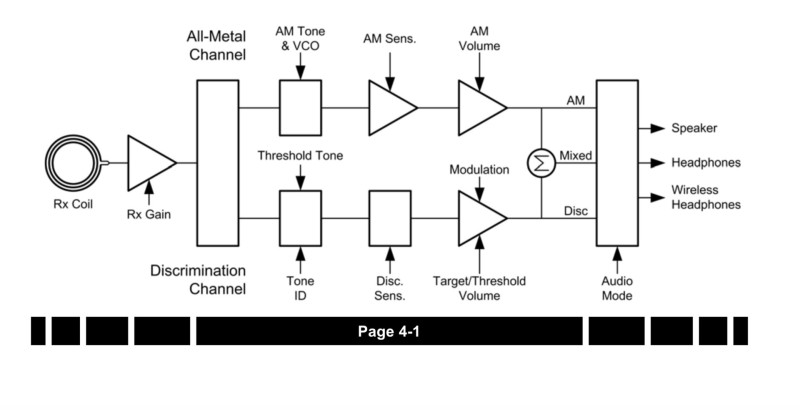-
Posts
20,046 -
Joined
Content Type
Forums
Detector Prospector Home
Detector Database
Downloads
Everything posted by Steve Herschbach
-

What’s The Difference?
Steve Herschbach replied to HardPack's topic in Metal Detector Advice & Comparisons
It’s about way more than frequency. When the circuit gets the results back, how are the results compared i.e. processed, to arrive at a desired result? It’s the proprietary processing algorithms where the magic takes place, and XP refers to in their commentary. The processing can be additive, subtractive, etc. two machines with exactly the same frequency “weighting” can have totally different responses. It’s like knowing both our cars have eight cylinder engines, and trying to derive performance data from that, without knowing the rest of the details. My 6 cylinder can outperform your 8 cylinder, and vice versa, based on other aspects. So whiles it’s all interesting stuff, I simply test the detectors on my targets in my ground, and go with that. The rest is “forum fodder”- 9 replies
-
- 6
-

-
- detector tech
- nokta legend
-
(and 1 more)
Tagged with:
-
It’s purely a matter of how deep the targets are, and trash to “good stuff” ratio. If you have lots of targets a VLF can reach, with lots of trash, VLF will win almost every time. You’ll just dig too much trash with the PI, no matter which it is. But if the surface is scoured clean of targets a VLF can reach, now it’s time to break out the PI, while the VLF crowd goes home empty handed. I’ve an old saying… “use a VLF when you can, and a PI when you have to” and it refers to just this sort of thing. If always go VLF if I can, but some places that just gets you nothing, so time for the PI.
-

New Coil For Ftp
Steve Herschbach replied to ☠ Cipher's topic in First Texas - Bounty Hunter, Fisher & Teknetics
Everything except when a person can get one, and what it costs. It's bad enough that we get this kind of months or years long teasers over a new detector, but a new coil? -
I’d go a step farther and say Best Video Metal Detector Instructor - All Brands. If there is a detector I’m interested in I want to hear about it, and nothing else. White’s set the standard for this type of videos early on, with hour long, in depth video “instruction manuals” for models like the MXT. Really great stuff. Minelab has put out some nice tech type videos. I’ll do my own comparing - what I want is in depth info, that goes beyond what is in the instruction manual.
-

One Touch Button To Check Targets / Horseshoe Button
Steve Herschbach replied to Rrnp's topic in XP Deus II Forum
Nor was it new or groundbreaking on Deus. Which is beside the point. Run wide open, adjust tone volumes as needed, no real need for horseshoe. But it’s nice to have anyway, and I do use it for those rare times when I actually do reject or notch out targets, and can see why people like having it. -

Thinning Down The Herd ??
Steve Herschbach replied to scoopjohnb's topic in Metal Detector Advice & Comparisons
Just sold the Garrett Apex, Tarsacci MDT 8000, Nokta Simplex+, and a spare Goldmaster 24K. Still leaves me with GPX 6000, Garrett 24K, White’s DFX, and Equinox. Deus II on order. That will do me just fine for 2022. The only thing that I’m on the lookout for is another PI to complement my GPX 6000, something a little more beach and coin/relic oriented, but what I want does not quite exist yet, so I’m not holding my breath. Looks like I’ll be settling at 5-6 detectors, with just a couple of those accounting for nearly all my detecting. Right now that would be GPX 6000 and Equinox, but maybe Deus II will change that equation. We’ll see. I’m looking forward to 2022. -

One Touch Button To Check Targets / Horseshoe Button
Steve Herschbach replied to Rrnp's topic in XP Deus II Forum
No idea what you mean here Hugh. I always run the Nox accepting ferrous but with iron volume set low. As you say, negating need to have horseshoe button. Tone Volume - A relatively new feature allows some detectors to set the volume of the ferrous (iron and steel) tones to be lower than the volume of non-ferrous tone responses. This can be much easier on the ears in locations full of ferrous trash where every swing of the coil produces many ferrous responses, with the non-ferrous responses being few and far between. Both the Equinox 600 and 800 can adjust the ferrous tone volume. Relic hunters in particular find being able to adjust the ferrous tone volume to be a very useful function. Again, this feature is available on both Equinox models. The Equinox 800 goes a step farther in allowing the non-ferrous tone volumes to be adjusted. Maybe you have coins set to give a high tone, but you have a hearing loss in the high tone range. The Equinox 800 allows you to increase the volume of the high tone response in relation to the other tones, making it easier to hear. This is most useful in the five tone mode, which by default has one tone for ferrous, and four separate tones for different parts of the non-ferrous discrimination scale. Each of these four non-ferrous tones can have individual volume levels. Equinox Full Tones Adjustment All a long backwards way big saying I’ll not miss the lack of button in the Deus 2, as it’s set up for the way I hunt anyway. -

The Nail Board Test And Sensitivity
Steve Herschbach replied to NCtoad's topic in Metal Detector Advice & Comparisons
I agree for separation type tests. I was thinking max depth tests where people are straining to hear a signal at all. A meter response would mean they would have to hit the same mark on the meter to be considered a signal. Think like old TR deflection meter days. -
Merry Christmas to one and all!
-

The Nail Board Test And Sensitivity
Steve Herschbach replied to NCtoad's topic in Metal Detector Advice & Comparisons
You “nailed” it Carl. The test itself just is what it is. But one of the most important factors in real world detecting is coil control and technique, which largely separates the real pros from everyone else, not the particular machine in use. Coil technique varies so wildly on Monte tests as actually performed, so as to render them almost useless for comparative purposes between different operators. I always imagined the perfect detector test is one that takes a person out of the loop. A adjustable mechanical sweep arm arrangement for the mechanics. And a digital meter reading to replace the audio, so that exact numeric audio output levels are compared, rather than poorly recorded audio on videos. These tests measure the people involved every bit as much as the detectors. Thats not to say they are a waste of time, and that one can’t glean good information from them. It just helps a lot if the eyeballs watching the videos have some knowledge of how easily the results can be manipulated just by varying the speed of the swing, or the often impossible to determine coil height as seen from the camera. Personally I like to include hot rocks in my own tests, plus various ferrous items that read non-ferrous, as I usually am more concerned with false positives than anything else. I therefore make my own test setups as required for my purposes alone, and only share the results in a generalized sense via my “opinions.” -

The Nail Board Test And Sensitivity
Steve Herschbach replied to NCtoad's topic in Metal Detector Advice & Comparisons
What the coil transmits is normally fixed, with transmit boost being a rare exception, where you can boost the voltage applied to the coil. Sensitivity or gain controls are therefore filters applied after the fact, that amplify or filter the signal from the coil in various ways. Most detectors have a single control that you actually don’t know what’s really going on, unless you experiment with it to see what happens. It’s a possible blend of functions in one control. The White’s V3i gives you direct access to several possibilities, the preamp gain (RX Gain), all metal sensitivity, and discrimination sensitivity. Reading the White’s V3i manuals can teach you a lot about detectors, especially the V3i Advanced User Guide. A basic circuit flow chart from page 4-1: The manual has excellent discussion of the sensitivity and threshold audio controls. My point here is the controls do not affect masking effects per se, as the coil properties are fixed. You are not increasing or reducing the field size or strength, but in general simply doing an audio amplification process. Reducing gain or sensitivity will suppress some signals to where they will not be heard, allowing only the strongest signals to break through. If you primary desired target signal is stronger than the undesirable signals, reducing sensitivity can suppress or totally eliminate the undesirable signals. If the primary target becomes fainter, as it often will, increasing volume can offset this. Long answer to say yes, reducing sensitivity and possibly increasing volume can save your mind and sanity, and produce cleaner results. But note that when striving to reach the deepest, faintest signals, this is not a good idea, for what I’d hope are obvious reasons. However, what they can’t do is actually modify what the coil is doing in something like the Monte test, as that part of the equation is fixed. What may work however is actually raising the coil. Being too close can create overload situations from the targets being too close to the the coil, and since the coil field is globular is shape, raising the coil can reduce extraneous edge i.e. masking effects, by working a smaller “tip” of the field. -

White’s TDI Battery Modifications
Steve Herschbach replied to BeachBunnyTRHunter - DP's topic in White's Metal Detectors
I put up a huge list of links about making boosted battery packs for TDI. The benefit would be obvious - more depth. This other post best explains the possible downside… -

White’s TDI Battery Modifications
Steve Herschbach replied to BeachBunnyTRHunter - DP's topic in White's Metal Detectors
I moved this to its own thread to compile all the past threads on the subject in one location. Pretty much everything you’d ever want to know, if you wade through the pages of posts below. In the future this will provide a master reference in the subject. https://www.detectorprospector.com/forums/topic/9823-tdi-battery-voltage/ https://www.detectorprospector.com/forums/topic/12385-tdi-sl-factory-battery-pack-vdc-differences/ https://www.detectorprospector.com/forums/topic/7677-simple-148v-battery-pack-for-tdi-beach-hunter/ https://www.detectorprospector.com/forums/topic/10658-whites-tdi-sl-4x18650-battery-tray-made-simple/ https://www.detectorprospector.com/forums/topic/14075-tdi-pro-18v-battery-pack-5-x-18650-with-dedicated-charger/ https://www.detectorprospector.com/forums/topic/11051-white’s-tdi-beach-hunter-update-after-15-months/ https://www.detectorprospector.com/forums/topic/15228-tdi-beachhunter-going-back-to-12v-and-why/ https://www.detectorprospector.com/forums/topic/10670-why-is-everyone-wanting-to-jackup-the-voltage-on-some-white’s/ Other TDI Electronic Modifications -

Programs Tadpole 4 And Ghost 4 For Ctx3030
Steve Herschbach replied to Melano87's topic in Minelab Metal Detectors
More information about where you heard about them, and what they do, might help. -

One Touch Button To Check Targets / Horseshoe Button
Steve Herschbach replied to Rrnp's topic in XP Deus II Forum
XP Deus 2 User Manual -

Deus 2 Vs Deus 1 Vs Equinox 800
Steve Herschbach replied to Seiko's topic in Metal Detector Advice & Comparisons
It’s Deus, not Dues. I fixed the title, but will leave editing your post up to you. Upper right, three little dots, choose “edit” Yes, many people like owning both a Deus and an Equinox. Not uncommon at all. Some however would like the best of both in one detector. It’s all about having different options to suit different people, not force everyone to do the same thing.- 19 replies
-
- 4
-

-
- minelab equinox
- xp deus
-
(and 1 more)
Tagged with:
-

Garrett ATX Backpack Modification
Steve Herschbach replied to Steve Herschbach's topic in Garrett Metal Detectors
The ATX design is decades newer than either the Sea Hunter, which is old school straight PI, or the TDI, which is a direct port of the Eric Foster ground balancing PI, the Goldscan. The Goldscan/TDI is a single channel ground balancing PI, and as such has a huge “hole” in the detection of items around the ground balance point. Some gold rings will experience a 50% or greater loss of depth in this “hole”, and it is a major reason you should run ground balance off in a beach scenario if at all possible with the TDI. The ATX is a modern dual channel design more akin to the Minelab SD series, which uses overlapping but offset dual channels to eliminate the ground balance hole. Details Here and More Details Here The ATX is also very good on smaller items like small gold nuggets, able to hit 1/10th gram gold nuggets with no problem. I’m a huge ATX fan but frustrated by the heavy military housing. If we ever get an ATX in a modern housing, I’ll be first in line to get one. -

Garrett ATX Backpack Modification
Steve Herschbach replied to Steve Herschbach's topic in Garrett Metal Detectors
Yes, dealers have restrictions on territory and where they can sell. Out of country sales are normally prohibited, as each country or region has their own distribution channel. I was a multi line dealer in Alaska, and could sell almost nothing into Canada, for instance. You can find dealers who will violate these policies, but the buyer of the detector can run afoul of issues if warranty work is needed, as these are considered “grey market” merchandise. I also got a sling for a broken arm that worked well holding the ATX body next to the side instead of on back. -

Meeting Gary Drayton
Steve Herschbach replied to BeachBunnyTRHunter - DP's topic in Metal Detecting For Jewelry
Please post it here… thanks. -

Are The HF Coil’s Compatible With The Deus 11 ?
Steve Herschbach replied to Ridge Runner's topic in XP Deus II Forum
I’d not argue with that. I expect a new version of the 6x10 from XP myself someday. I hope. -
https://www.detectorprospector.com/forums/topic/5715-minelab-e-trac-ctx-3030-excalibur-versus-equinox/ https://www.detectorprospector.com/forums/topic/6935-equinox-or-ctx-3030/ https://www.detectorprospector.com/forums/topic/10145-thoughts-on-ctx-and-equinox-after-long-term-use/ https://www.detectorprospector.com/forums/topic/10804-equinox-800-and-ctx-3030/ https://www.detectorprospector.com/forums/topic/13980-ctx-vs-equinox-800/ For me it’s simple. If I was offered a CTX for same price as an Equinox, I’d grab it. You can debate performance all you want, but that’s half what the machine is worth used. You can’t go wrong, assuming it’s in good condition. Try it, and if you don’t like it, sell it and put extra money in your pocket.
-

Update Of Nokta Makro Legend Shipping & Manual
Steve Herschbach replied to HardPack's topic in Nokta Legend Forum
You mean like the huge battery that the Equinox uses? It’s not like NM has not done this spare battery thing before. You can type caps all you want, but the main battery is built into the pod, and the spare battery clips under the arm, both providing additional running time, and charging the detector at the same time. You can do same with a Equinox and Apex. None of this is news. -

Diving Counterweight For TDI Beachhunter
Steve Herschbach replied to pjrough's topic in White's Metal Detectors
-

Are The HF Coil’s Compatible With The Deus 11 ?
Steve Herschbach replied to Ridge Runner's topic in XP Deus II Forum
There is no reason coils that are not multifrequency could not be programmed into the software. XP coils are the metal detector, the controller is just a controller.



